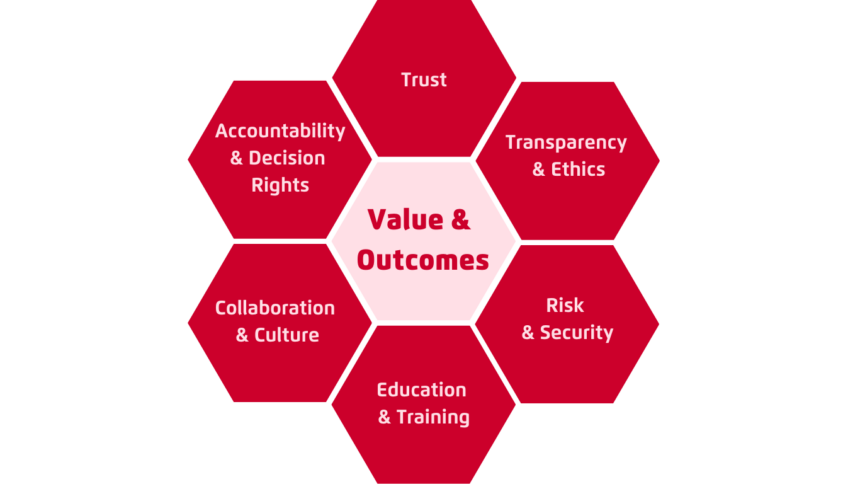
.
Legislation concerning a customer’s right to be forgotten is where Data Governance (DG) truly shines. DG focuses on the entire lifecycle of data and records within the business and beyond, ingraining an organisational culture where people genuinely care about data and its value.
.
A recent data breach by NatWest involving Mr. Farage highlights the risks associated with a careless or indifferent approach to data. The consequence of this breach was the CEO losing their job and the company share price plummeted. While it may seem that an individual employee within the organisation passed on the data, it is important to recognise that the responsibility for such breaches ultimately falls on the organisation, regardless of the actions of its employees. In the words of the Information Commissioner’s Office (ICO) regarding the recent NatWest case, “We confirm that we did not investigate Ms. Rose’s actions, as NatWest was the data controller under investigation.” (source)
While regulatory control is often perceived as the driver for pursuing robust data governance, the advantages of its implementation stretch way beyond mere compliance. Having a good data governance framework ensures optimal data quality and privacy, supports predictive analysis, supports change management, and improves customer satisfaction. It’s framework is pivotal to driving digital transformation initiatives such as cloud migration, data lake management, and management of the explosion of data organisations now have access to.
In our last blog we reviewed the principles and frameworks for good data governance and outlined the business case for implementing them. In this blog we will explore, how can the business achieve its data governance framework?
The Seven Key Foundations for Modern Data & Analytics Governance
As data professionals, our primary responsibility is to support the business and help it achieve its governance objectives. The use of appropriate tools can streamline processes, enhance productivity, and eliminate time-consuming manual tasks. For instance, when it comes to tasks such as locating and purging customer data across multiple systems, efficient governance plays a crucial role. Ultimately, governance can result in significant efficiency gains throughout the organisation.
Understanding the Components of a Data Governance Framework
Data governance is a complex topic that involves various people, processes, rules, and various essential components. To navigate this intricate landscape effectively, consider the following questions:
- Do you have a comprehensive understanding of where all your data is stored?
- Can you readily identify the specific types of data and their locations? (e.g., customer data, financial data, product data, supplier data, employee data, Personally Identifiable Information or PII)
- Have you effectively communicated the permissible uses of your data?
- Are you aware of the pathways data takes as it flows through your organisation?
As a data custodian, you’ll often face inquiries from within your organisation, necessitating prompt responses to questions such as:
- What is the source of this data?
- Who within the organisation has access to it?
- Are you engaged in interactions with external systems and data sharing, and is this interaction appropriately documented?
- Are you aligning with the established company data governance framework in terms of defining data usage, adhering to policies, and following the relevant processes?
These questions emphasise why data governance is of utmost importance and what it encompasses. Essentially, data governance is the process of managing the quality, security, accessibility, and usability of your data assets.
Embarking on a data governance journey!
It’s crucial to define key roles within your organisation. Two critical roles you’ll frequently encounter are the Data Owner and the Data Steward. While these titles may vary, the fundamental responsibilities remain consistent.
The Data Owner is typically a senior stakeholder accountable for one or more data sets. They are the individuals who genuinely care about data accuracy and its use.
The Data Owner holds the authority to drive change, allocate budgets, modify processes, and lead investigations when issues arise. The specific Data Owners may differ depending on the data type, usage, and organisational structure.
In contrast, the Data Steward assists the Data Owner in their responsibilities. They handle day-to-day governance activities, including policy updates, data associations, and classification. The way these roles manifest can vary between organisations, depending on their size and complexity. Larger enterprises may have multiple Data Owners and Data Stewards, while smaller organisations might combine these roles.
Moving Beyond Spreadsheets to Improve Data Governance
Spreadsheets, there are limits!
Many organisations initially rely on manual systems or spreadsheets to manage data governance components such as data cataloguing and business glossaries. This method involves painstakingly collecting metadata from various systems and documenting details in spreadsheets. However, this approach has its limitations and presents risks:
Error-Prone: Manual data entry will lead to errors, potentially causing costly issues.
Limited Scalability: Spreadsheets become unwieldy as data complexities increase.
Lack of Automation: This method lacks automation and efficiency in gathering and updating data.
Poor History Tracking: Maintaining historical data changes becomes challenging.
To overcome these challenges, it’s advisable to transition from manual systems to dedicated data governance tools like Informatica’s Intelligent Data Management Cloud. These tools offer automation, machine learning, and the ability to create a robust data catalogue that is crucial for efficient data governance.
The tools can automatically discover and catalogue data assets, making it easier to classify and manage data. Additionally, they offer recommendations for data classification based on AI and machine learning. This enhances accuracy and helps users easily find relevant data assets.
This upgraded approach streamlines data governance processes, ensures data accuracy, and simplifies the management of data assets. It eliminates the pitfalls associated with manual spreadsheet management, promoting a more efficient and error-free data governance strategy.
Feel free to reach out to reach out to Sam Boulton on 020 3137 9944 if you have any more questions on how to embark on your data governance journey!
Missed our Data Governance Master? Watch it on-demand here
About the author
With more than 25 years’ experience in technology solutions, Tom leads the Data & Analytics practice within Sempre. Tom has been with Sempre from the beginning and has worked across the full programme lifecycle to advise, scope, deliver, and manage, high-value programmes for our customers. He has a wide breadth of experience in all aspects of the data management lifecycle, including data solutions, strategy, governance, master data management and quality, having delivered transformational data solutions across multiple industry sectors.
.




